American Southwest art encompasses a rich blend of Native American and Hispanic influences. It showcases a variety of traditional forms, such as pottery, weaving, and silver jewelry. This art often features bold color schemes and intricate designs that reflect the region’s natural beauty and cultural narratives. By preserving these unique traditions, artists maintain a strong connection to their heritage. Understanding this art’s history and characteristics can reveal much about the people and landscapes of the American Southwest.
Highlights of American Southwest Art
- American Southwest art blends Native American and Hispanic traditions, showcasing a rich cultural heritage influenced by historical practices and beliefs.
- Key characteristics include bold, earthy colors, symbolism, and depictions of nature, reflecting the region’s landscapes and mythology.
- Common art forms include pottery, weaving, jewelry, and textiles, emphasizing traditional techniques and craftsmanship.
- Southwestern art plays a significant role in home decor, adding warmth and cultural significance through vibrant designs and unique accessories.
- The art influences contemporary fashion, merging traditional patterns with modern aesthetics to celebrate regional heritage and sustainable practices.
Exploring American Southwestern Art
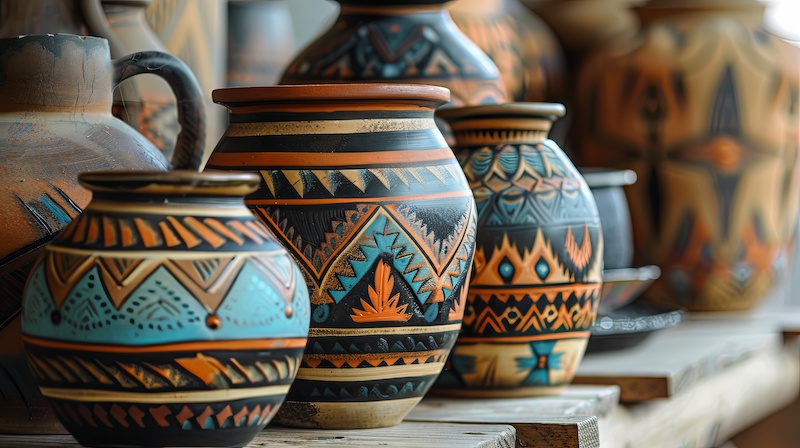
American Southwestern art is a vibrant reflection of the region’s rich cultural heritage. It blends the traditions of Native American tribes with Hispanic influences. This art form includes pottery, textiles, painting, and jewelry, showcasing techniques developed over centuries. When applied to interior design, you’ll typically see examples of the art form alongside natural wall decor.
The Ancestral Puebloans, formerly the Anasazi, introduced essential agricultural practices and pottery methods about 4,000 years ago, shaping the area’s artistic traditions. Meanwhile, the Hohokam culture, emerging around 300 CE in Arizona, laid the groundwork for modern tribes and influenced farming and creative expression.
The introduction of silver jewelry in the late 19th century marked a significant shift as Native American artisans began adopting European styles. Events like the Santa Fe Indian Market highlight the ongoing evolution of Southwest and American Indian art today.
Characteristics of Southwestern Art
When you look at Southwestern art, you’ll notice a mix of Indigenous and Spanish influences, which create a unique style. Artists often use bold, earthy color schemes to reflect the natural landscapes around them, showcasing mountains, deserts, and rivers.
Additionally, symbolism and mythology play a significant role, with handcrafted pieces that tell stories and connect with the region’s rich cultural heritage.
Indigenous and Spanish Influences
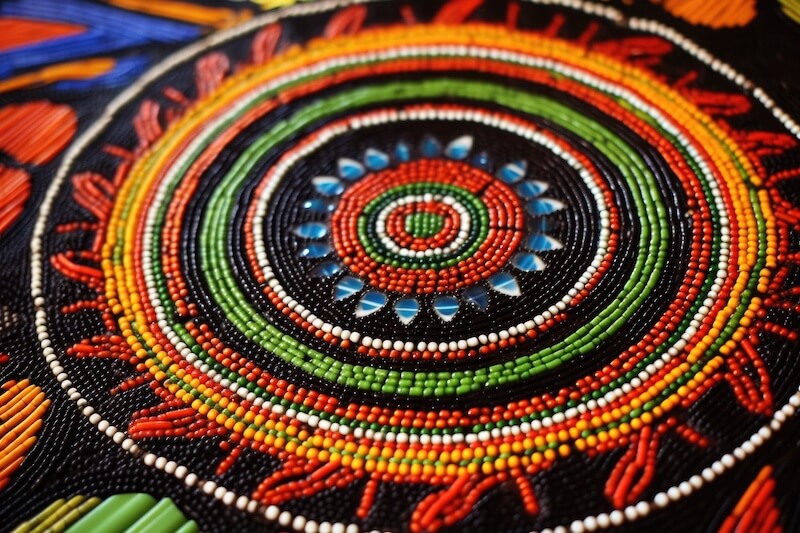
Southwestern art showcases a fascinating blend of Indigenous and Spanish influences, creating a unique cultural tapestry.
Native American art—particularly that of the Pueblo, Navajo, Hopi, and Apache peoples—highlights traditional pottery, weaving, and beadwork techniques. This Indigenous influence is seen in petroglyph-style imagery—often called Native American rock art—that tells stories and connects to nature.
Spanish colonists introduced new elements, such as Catholic iconography, ironwork, and tin art (hojalata). This merger of cultures is evident in retablos, which are religious paintings on wood, Santos, and wooden saint carvings.
Adobe structures also reflect this fusion, combining practical design with artistic expression. Together, these influences create a rich artistic heritage that continues to thrive in the American Southwest today.
Bold, Earthy Colors
Bold, earthy colors define the art of the Southwest, drawing inspiration from the region’s stunning natural landscape. These colors reflect the desert’s beauty, with shades like terracotta, ochre, and sienna mimicking sunbaked clay and rock formations. Deep blues and turquoise capture the sky’s vastness and hold significance in southwestern Native American jewelry.
Sage green and dusty brown echo the desert plants and arid terrain, while sunset hues like burnt orange—plus the range of colors that go with orange—and deep purples add warmth to the artwork.
Artists use earthy colors in pottery, textiles, paintings, and murals, creating a strong connection to the land. This vibrant Southwest palette showcases the region’s heritage and tells stories rooted in culture and traditions.
Depictions of Nature and Landscapes
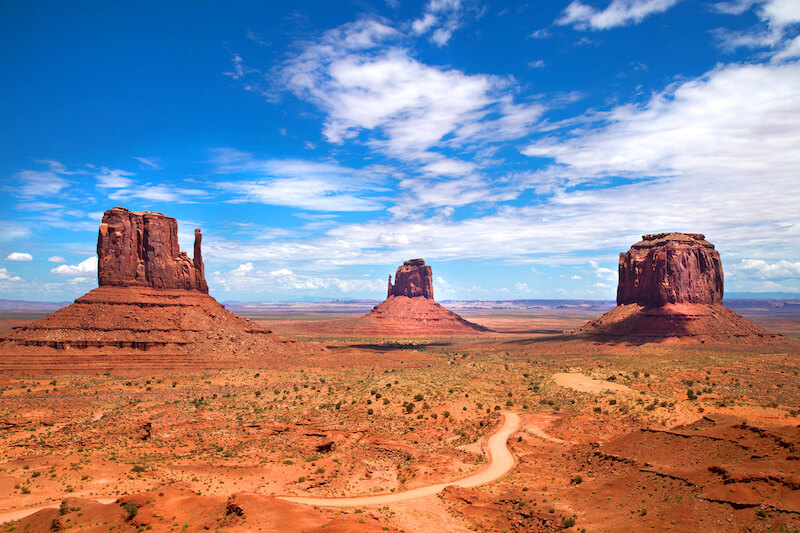
Art from the American Southwest often captures the region’s breathtaking landscapes and natural features.
Vibrant depictions of red rock canyons and mesas, like those in Monument Valley and Sedona, showcase the area’s unique geology. Southwestern artists frequently portray expansive desert landscapes filled with rolling dunes and sparse vegetation, highlighting the beauty of cacti, sagebrush, and yucca plants.
Additionally, dramatic skies, often painted in vivid sunset hues or stormy cloud formations, add depth to these works. It’s common to see accented neutral color palettes used in Southwestern art, as they enable the artist to capture the clash of earthy colors with vibrant expressions of the sunset or wildlife. Iconic artists, such as Georgia O’Keeffe, became renowned for their interpretations of the Southwestern U.S. environment.
Symbolism and Mythology
While exploring the symbolism and mythology in Native American art, these elements convey deep spiritual meanings and cultural significance. For instance, Hopi Kachina dolls represent spirits that guide and protect communities as a link between the physical and spiritual worlds.
You’ll also notice ancestral symbols woven into pottery, weaving, and sand paintings, reflecting the deep-rooted traditions of these cultures. Other symbols, like Kokopelli, a fertility deity, and motifs of the sun and moon, illustrate life cycles and balance. Thunderbirds and eagles symbolize strength and divine presence, while Zuni animal fetishes are believed to carry spiritual energy.
These elements create a profound narrative within Southwestern art, connecting people to their heritage.
Handcrafted Aesthetic
Handcrafted aesthetics define Southwestern art, showcasing the skills and traditions of Indigenous artisans. This art form emphasizes native craft and is an excellent inspiration for DIY home decor projects, utilizing local materials and techniques passed down through generations.
For instance, Pueblo pottery is made using ancient coiling methods and often features geometric patterns in black-on-white or red-on-tan colors. Similarly, Navajo textiles, especially handwoven wool rugs, are known for their bold and symmetrical designs, which reflect their cultural significance.
Intricately designed silver and turquoise jewelry from Hopi, Zuni, and Navajo artisans further exemplifies this handcrafted approach. Additionally, sand paintings in Navajo healing ceremonies depict sacred figures and symbols.
Storytelling Through Art
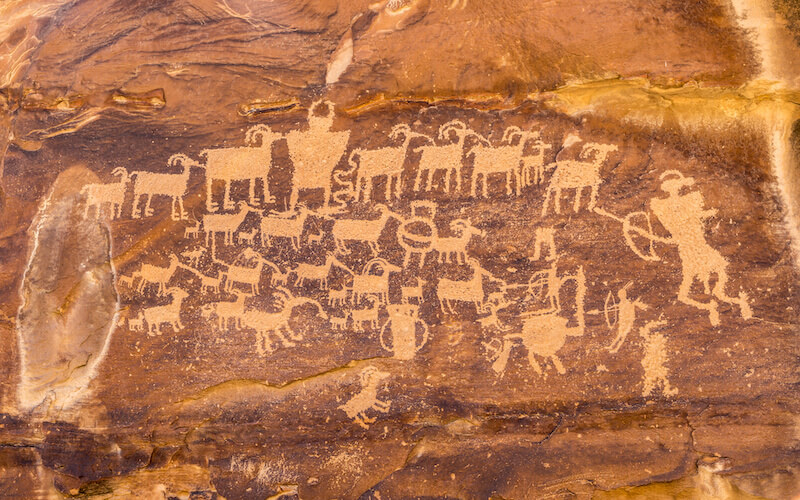
Southwestern art serves as a vibrant medium for storytelling, deeply rooted in the traditions and histories of Indigenous cultures. This art form conveys oral histories, legends, and spiritual teachings, making it a powerful narrative tool.
Storytelling is especially prominent in Hopi and Zuni ceremonial art, where intricate symbols carry profound meanings about creation and nature. Traditional pictorial pottery features visual storytelling, illustrating historical events, rituals, and mythology.
Additionally, ancient petroglyphs and pictographs depict stories of survival, migration, and spiritual beliefs, connecting the past to the present. Modern Southwest paintings and murals reflect daily life and Indigenous resilience, showcasing how stories evolve.
Strong Use of Geometric Patterns
Geometric patterns are prominent in American Southwest art, reflecting cultural significance and artistic skill.
You’ll often notice these designs in Navajo rugs and blankets, where chevrons, diamonds, and stepped patterns create striking visuals. Additionally, geometric designs appear in pottery, featuring angular shapes and symmetrical motifs that tell a story.
Hopi and Pueblo murals also showcase these patterns, painted onto kiva walls to depict ceremonial imagery. Even adobe architecture incorporates geometric forms, with zigzag rooflines and stepped facades enhancing the aesthetic.
Many of these designs hold symbolic meaning, representing nature, the elements, and balance. Their visual appeal is abundant, and such designs are popular for textiles, furniture, and as centerpieces for gallery walls. This strong use of geometry highlights the artistry and connects to the rich cultural traditions of the Southwest.
Rustic and Textured Finishes
While exploring the art of the American Southwest, you’ll notice a strong emphasis on rustic and textured finishes that reflect the region’s natural environment.
Artists often use natural stone, clay, and adobe, connecting their work to the landscape. Hand-coiled pottery showcases the unique imperfections of craftsmanship, making each piece distinctive and personal.
Rough-hewn sculptures embody a raw, organic feel, emphasizing the beauty of unrefined forms. Similar to coastal wall decor and interior design, distressed wood and reclaimed materials are commonly found in furniture and home decor, adding to this earthy aesthetic.
Layered or textured paintings mimic the cracked, sunbaked surfaces of the desert, further enhancing the overall rustic appeal.
Southwest Art in Home Decor
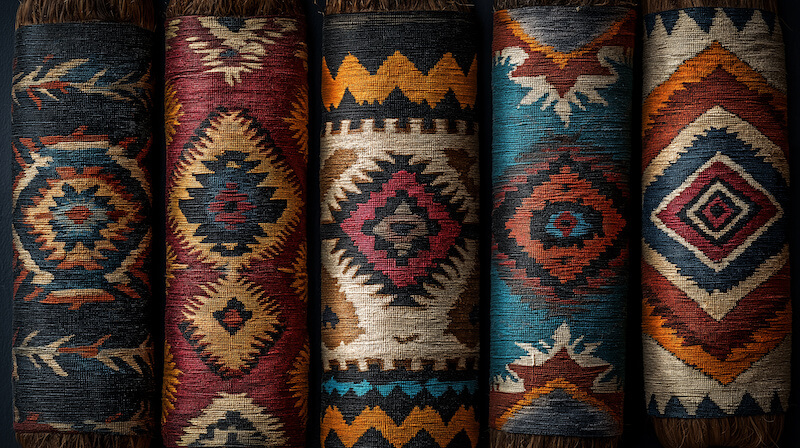
Incorporating Southwestern art into home decor can transform a space with vibrant colors and rich textures. To reflect the region’s cultural heritage, you can choose Southwestern wall art, decorative accessories, and textiles, such as Navajo rugs.
Framed prints and photography, which showcase the stunning landscapes and artistic traditions of the American Southwest, also make great additions.
Decorative Accessories and Textiles
Decorative accessories and textiles can bring the spirit of the American Southwest into your home. For example, you can enhance your space with decorative pottery, showcasing unique designs.
Acoma pottery features striking thunderbird motifs, and Zuni pottery, made from local clay, displays vibrant colors from organic dyes. Incorporating Navajo textiles, such as their beautifully woven rugs, adds warmth and character to any room.
These textiles, crafted using traditional techniques, are known for their geometric patterns and rich reds, browns, and blues. Additionally, Pueblo storyteller dolls, often adorned with textiles, tell cultural stories and serve as educational decor.
Framed Prints and Photography
When you add framed prints and photography of American Southwest art to your home decor, you invite a vivid representation of the region’s unique culture and landscapes. If you’re seeking a Southwestern aesthetic, you can use the styles, designs, and techniques as inspiration for the wall art in your home.
These artworks often showcase iconic scenes, like desert sunsets and ancient Puebloan ruins, using vibrant colors that capture the Southwest’s beauty. Many artists create high-quality framed prints using archival materials, ensuring the colors remain bright and resist fading over time.
You can choose from reproductions of famous pieces or original works by contemporary artists. Additionally, natural materials like reclaimed wood frames enhance the earthy tones in Southwest art, helping achieve a desert modern interior.
The Beauty and Function of American Southwest Art
American Southwest art uniquely blends Native American and Hispanic traditions, showcasing the region’s rich cultural heritage. Its vibrant colors and intricate designs reflect the area’s natural beauty and spiritual stories. This art form enhances home decor for Pueblo-style and other Southwestern homes and serves as an essential link to the past, preserving the identities and histories of the communities it represents. Understanding this art helps us appreciate the diverse influences that shape the American Southwest.




